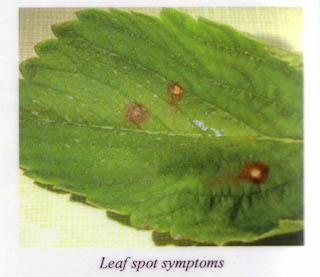Gray, fuzzy mold on berries
Cause
Gray mold (Botrytis cinera), a fungal disease.
Treatment
Disease symptoms are often worse in cool, wet conditions. Avoid excessive irrigation, clean up and remove crop debris. Resistant varieties, and approved fungicides are available.
Hard, bitter-tasting, or discolored berries
Cause
Leather rot (Phytophthora cactorum), a fungal disease causing irregular berry colors including white, brown, or purple.
Treatment
Avoid excessive irrigation, clean up and remove crop debris. Plant resistant varieties. Approved fungicides are not available.
Deformed or misshapen berries

Cause
The tarnished plant bug (Lygus lineolaris), a brown insect, roughly 1/4" long. Damage is caused by this insect feeding on the the developing seeds of the strawberry.
Treatment
When deformed fruit is noticed it is usually too late to control this pest. Remove weeds adjacent to strawberry fields to eliminate overwintering sites. Plants should be monitored while fruit is still green. Growers can check for this insect by holding a white paper under foliage and shaking the leaves. Immature tarnished plant bugs--which are often green in color--are easily spotted against the white background. When insect populations reach approximately 1 per plant, insecticides should be applied. To protect honeybees and other pollinators, insecticides should not be applied during the bloom period.
Leaf spots

Cause
Leaf spot (Mycosphaerella fragariae and Diplocarpon earlianum), two different fungal diseases which are difficult to distinguish from each other. Spots are often purple in color.
Treatment
Avoid excessive irrigation, clean up and remove crop debris. Plant resistant varieties. Approved fungicides include various copper formulations. Also space rows at least 18 inches apart to maintain adequate air circulation.
Clipped or cut flower buds

Cause
The strawberry bud weevil (Anthonomus signatus), a small (1/10") reddish brown insect with a long curved snout--closely related to the famous cotton boll weevil. Female weevils lay eggs within flower buds then girdle the stem to prevent it from opening.
Treatment
Treat with insecticide when there is 1 cut bud on every 4 or 5 plants. Some pesticides are approved for use against this insect. Treatments must be applied prior to bloom.